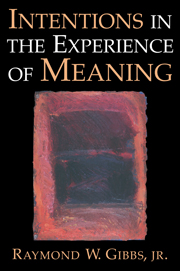Book contents
- Frontmatter
- Contents
- Acknowledgments
- Part I INTRODUCTION
- Part II SEARCHING FOR INTENTIONS
- Part III INTENTIONS IN DISCOURSE
- Part IV INTENTIONS IN CRITICISM
- Chapter 8 QUESTIONS OF AUTHORSHIP
- Chapter 9 LITERARY INTERPRETATION AND CRITICISM
- Chapter 10 INTERPRETING THE LAW
- Chapter 11 UNDERSTANDING ART
- Part V CONCLUSION
- Notes
- Name Index
- Subject Index
Chapter 11 - UNDERSTANDING ART
Published online by Cambridge University Press: 05 June 2012
- Frontmatter
- Contents
- Acknowledgments
- Part I INTRODUCTION
- Part II SEARCHING FOR INTENTIONS
- Part III INTENTIONS IN DISCOURSE
- Part IV INTENTIONS IN CRITICISM
- Chapter 8 QUESTIONS OF AUTHORSHIP
- Chapter 9 LITERARY INTERPRETATION AND CRITICISM
- Chapter 10 INTERPRETING THE LAW
- Chapter 11 UNDERSTANDING ART
- Part V CONCLUSION
- Notes
- Name Index
- Subject Index
Summary
One of the most notorious artistic projects of the twentieth century began in New York City in 1917 when Marcel Duchamp, along with several companions, purchased a urinal from a plumbing manufacturer. Duchamp took the urinal back to his studio, turned it upside down, and printed the name R. Mutt and the date in large black letters on the lower left rim. He then submitted this object, entitled Fountain, to the 1917 Independents exhibition, along with a six-dollar membership fee and a fictitious Philadelphia address for Mr. Mutt.
The directors of the art exhibition declined to include Mr. Mutt's submission of Fountain in their show, responding that the object was “by no definition, a work of art.” Marcel Duchamp soon published an unsigned editorial in a local magazine to describe Mr. Mutt's case, which read, in part: “Whether Mr. Mutt with his own hands made the fountain or not bears no importance. He CHOSE it. He took an ordinary article of life, placed it so that its useful significance disappeared with the new title and point of view – created a new thought for that object.”
Does present-day understanding and aesthetic appreciation of Fountain depend on, or demand, recovering something about Marcel Duchamp's communicative intentions in “creating” this piece of artwork?
- Type
- Chapter
- Information
- Intentions in the Experience of Meaning , pp. 293 - 322Publisher: Cambridge University PressPrint publication year: 1999



